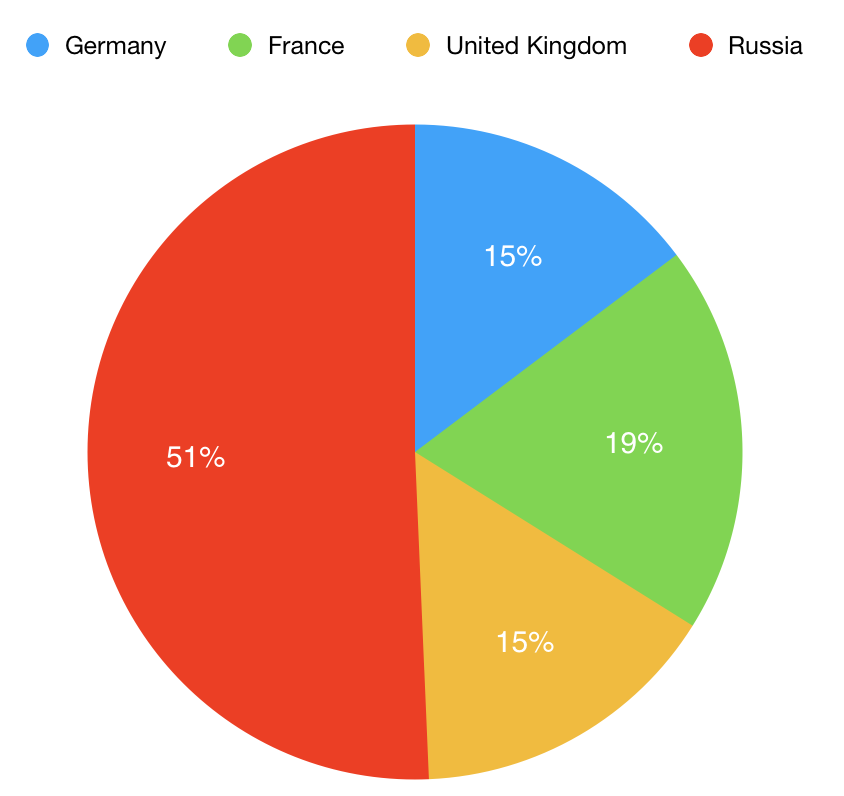The size and durability of Russia’s defense budget and economy in general is a source of much debate. One particular figure that I often encounter is that Russia has an equivalent GDP to Spain. The meaning apparently is that a country the size of Spain cannot sustain an armed force to compete for world leadership in the long run.
For example, Danish rear admiral Nils Wang uses the Spain trope in this interview to OLFI before his retirement as chief of the Danish Defense Academy. Wang presents the case that the military tensions between NATO and Russia are not comparable to the Cold War because with a GDP the size of Spain’s, Russia will not be able to hold territory in Western Europe after an initial occupation.
There are a few problems with this line of reasoning. First, historically the USSR never had an impressive GDP either. There are many complicating factors when comparing economies of different countries, especially when one of them has a fundamentally different economic system like the communist one. But in general, it seems that in second half of the 20th century, the Soviet Union had a GDP which was smaller than the combined GDP of West Germany and France. The combined GDP of all NATO countries beat the Soviet GDP by many lengths.
Another problem with the Spain comparison is that things don’t cost the same in different countries. In some places you just get more for your money than in others. It is cheaper to have a large army if the wages are low and equipment is inexpensive. To account for that, you need to correct the GDPs for purchasing power parity (PPP) before comparing different countries.
Nominally, the GDPs of Russia and Spain are roughly in the same ballpark. In 2017, Russia was number 12 in the world with a GDP of 1,527,469 million USD, and Spain was number 14 with a GDP of 1,313,951 million USD. So Russia’s GDP was about 14 percent larger than Spain’s in 2017. But if the numbers are corrected for purchasing power parity, Russia is number 6 in the world, just a tiny bit behind Germany and well ahead of both the United Kingdom, France, or Spain. Russia’s GDP (PPP) was 4,007,831 million Int$, and Germany’s was 4,170,790 million Int$. (Source: IMF)
The very similar GDPs (PPP) between Russia and Germany give room for an interesting perspective: Their defense spendings as percent of GDP indicate the same amount of stuff that one could buy for that money.1
In 2017, Germany spent 44.3 billion USD on defense which amounted to 1.2 percent of GDP. Russia spent 66.3 billion USD, which was 4.3 percent of GDP (source: SIPRI). But because their GDPs with corrections for purchasing power parity are the same, Germany would have to increase their defense spending to 4.3 percent of GDP or 158.7 billion USD to afford the same investments as Russia.
Since playing with numbers is so much fun, I decided correct the defense budgets of Germany, France, and the United Kingdom for purchasing power parity and see how that compares to Russia’s military spending. With a GDP (PPP) of 4,007,831 million Int$ and a defense share of GPD of 4.3 percent, Russia’s defense planners had 172,336.7 million Int$ to spend in 2017. The other countries scored as follows:
In other words, corrected for purchasing power, Russia has a larger military budget than Germany, France, and the United Kingdom combined. Because graphs are fun too, I also illustrated this point.

Recently, there have been reports that Russia’s military budget declined by 20 percent in 2017 compared to 2016. Some have argued that this decline was inevitable given the poor condition of Russia’s economy. But as Michael Kofman has explained, Russia’s military budget is neither declining nor unsustainable. Instead, the apparent decline in defense spending in 2017 is due to technicalities like periodization of expenses in the national budget. Indicators suggest a stable level of defense spending which is sustainable in the long run in terms of manpower, materiel, and money.
So while Russia does have a GDP the size of Spain’s, that doesn’t say much about their military potential. More interestingly, Russia has a defense budget which gives them the same purchasing power as the combined military spending of Germany, France, and the United Kingdom. And they can afford to keep it up in the foreseeable future.
- As Oliker has pointed out, there are many complicating factors when comparing defense spending across borders. For example, it is different what countries include as defense expenses. If anything, such a consideration would only strengthen the argument in this article. European countries have incentives to make their defense spending appear higher than it really is, whereas Russia has incentives to make it appear lower. ↩


Leave a Reply